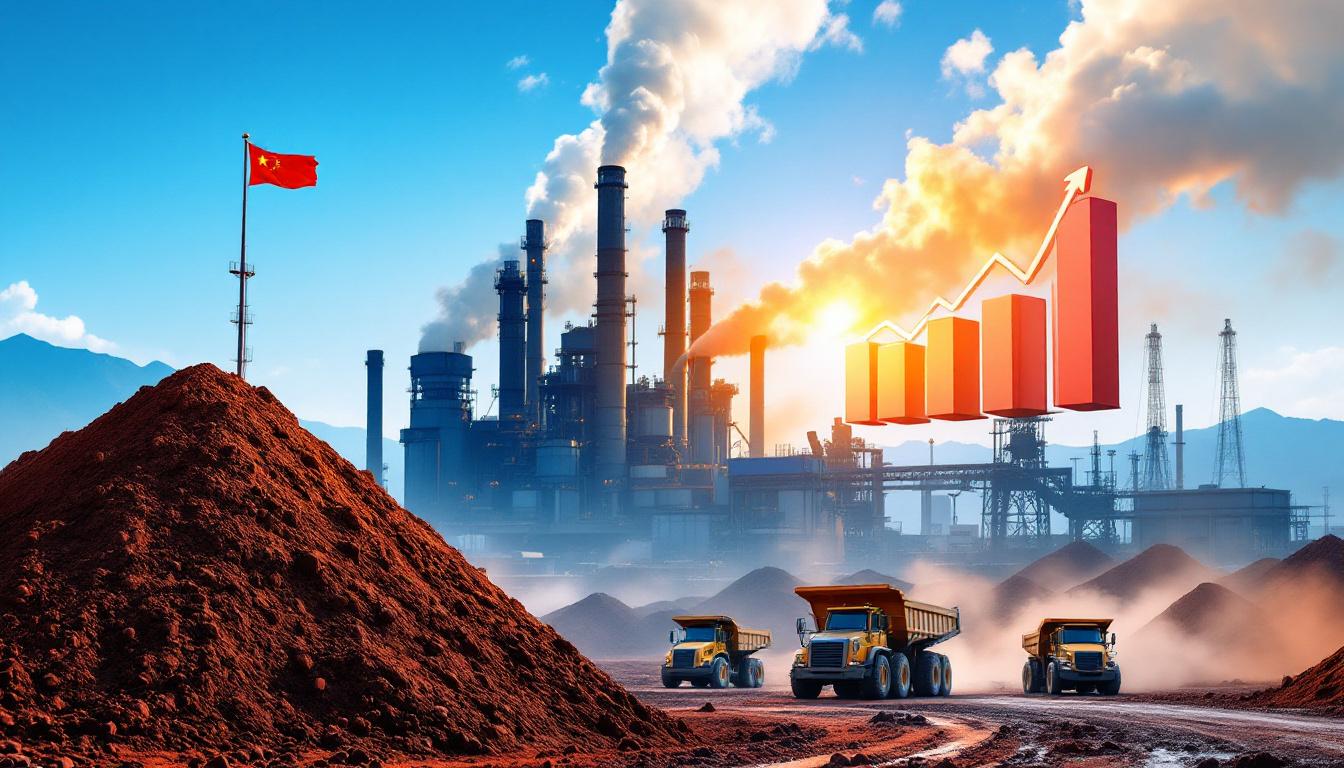How Is Copper Powering the Global Energy Transition?
The strategic importance of copper in the modern world cannot be overstated, particularly as nations worldwide accelerate their transitions toward renewable energy systems. Often called "the metal of electrification," copper sits at the heart of the clean energy revolution—a position that is reshaping global production patterns, investment priorities, and geopolitical considerations.
The Unprecedented Demand for Copper in Green Technologies
The clean energy transition is dramatically increasing copper intensity across multiple sectors simultaneously. This unprecedented demand surge stems from copper's unique properties—particularly its exceptional electrical conductivity, which makes it irreplaceable in energy transmission systems.
Electric vehicles represent one of the most significant drivers of new copper demand. A typical EV requires approximately 83 kg of copper—nearly four times the 23 kg found in conventional internal combustion vehicles. This difference becomes even more consequential when considering global EV adoption projections, which suggest that by 2030, EVs could account for 25-30% of new vehicle sales worldwide.
Renewable energy infrastructure creates another major demand stream:
- Wind turbines utilize between 2.5-6.4 tonnes of copper per megawatt of generation capacity
- Solar photovoltaic systems require approximately 5.5 tonnes of copper per megawatt
- Energy storage systems contain substantial copper in battery connections and management systems
- Grid modernization demands massive copper investments for efficient energy transmission
According to the International Energy Agency, meeting global climate targets will require a doubling of copper demand by 2040—a scale of growth unprecedented in the metal's production history.
Current State of Global Copper Production
Modern copper production has grown exponentially from its historical roots. Global output has expanded from approximately 5.9 million metric tons in 1970 to an estimated 23 million metric tons in 2024—representing nearly 290% growth over five decades.
This growth trajectory has not been linear, however, with production responding to complex market cycles driven by:
- Infrastructure development waves in emerging economies
- Technological advances enabling lower-grade ore processing
- Price signals stimulating or constraining investment
- Geological discoveries opening new production frontiers
- Political and regulatory changes affecting major producing regions
"The copper mining industry faces unique challenges compared to other metals. Unlike iron or aluminum, economic copper deposits are geologically rare and often found in complex, remote regions with significant infrastructure requirements." — Richard Adkerson, CEO of Freeport-McMoRan
Secondary production from recycled sources has grown in importance alongside primary mining output. Currently, recycled copper accounts for approximately 30% of global supply—a percentage that has gradually increased as collection systems improve and circular economy principles gain traction.
Which Countries Dominate Global Copper Production Today?
The global copper production landscape has transformed dramatically over recent decades, with production concentrating in specific regions blessed with exceptional geological endowments.
South America's Copper Powerhouses
Chile maintains its position as the world's leading copper producer with annual production of approximately 5.3 million tonnes—representing about 23% of global output. The country's dominance stems from world-class porphyry copper deposits in the Andean region, particularly the extraordinary resources found at operations like Escondida (the world's largest copper mine) and Collahuasi.
Chilean production benefits from:
- Exceptional geological conditions creating high-concentration deposits
- Well-developed mining infrastructure and export capabilities
- Decades of technical expertise in copper extraction
- Relatively stable mining investment frameworks
- Access to seawater for processing in water-scarce regions
Peru has solidified its position as the world's second-largest copper producer with approximately 2.8 million tonnes annually. Major operations like Las Bambas, Antamina, and Cerro Verde have established Peru as a critical supplier to global markets, though political instability has occasionally disrupted production growth.
Together, these South American giants account for more than one-third of global copper production—a concentration that creates both supply security risks and economic development opportunities within the region.
The Rapid Rise of African Copper
The Democratic Republic of Congo has emerged as one of the most significant developments in the copper production landscape, rising rapidly to become the world's third-largest producer. The country's Copperbelt region contains exceptionally high-grade deposits that provide critical competitive advantages in a market increasingly characterized by declining ore qualities.
"Congolese copper deposits often contain grades of 3-5%, compared to the global average that has fallen below 0.7%," notes mining analyst Paul Robinson of CRU Group. "This grade advantage translates to significantly lower production costs, even accounting for infrastructure and political risk factors."
Chinese investment has been instrumental in accelerating Congolese production capacity, with companies like China Molybdenum and Zijin Mining acquiring major assets and developing new projects. This investment pattern reflects China's strategic approach to securing critical mineral supplies while extending its economic influence throughout the African continent.
Zambia's copper industry, while experiencing more volatility than its neighbor, continues to contribute significantly to global copper supply forecast through operations in its portion of the Copperbelt region.
Traditional Producers Maintaining Relevance
While South America and Africa have captured increasing market share, established copper-producing regions continue making substantial contributions to global supply:
Australia maintains consistent production through technological innovation and operational efficiency. Operations like Olympic Dam (which produces copper alongside uranium, gold, and silver) exemplify the country's approach to maximizing value from complex orebodies.
North American production remains significant despite declining relative market share. The United States produces approximately 1.3 million tonnes annually, with significant operations in Arizona, Utah, and New Mexico. Canadian and Mexican output further strengthens the continent's contribution to global copper markets.
Russia continues as a substantial producer despite geopolitical complications affecting its integration with global markets. The country's production is dominated by Norilsk Nickel and the Russian Copper Company, with significant operations in Siberia and the Ural Mountains.
What Factors Have Reshaped Copper Production Geography?
The distribution of copper production capacity has undergone significant transformation, driven by a complex interplay of geological, technological, and political-economic factors.
Geological Discoveries Changing the Production Map
Major copper discoveries have repeatedly reshaped production geography throughout history. The most consequential discoveries in recent decades have been concentrated in the Andean region of South America, the Central African Copperbelt, and parts of Central Asia.
These discoveries follow distinct geological patterns:
- Porphyry copper deposits: Large, low-to-medium grade systems that account for approximately 60% of global copper production, primarily found in the Americas and parts of Asia-Pacific
- Sediment-hosted deposits: Stratiform copper systems particularly important in African production
- Volcanic-associated massive sulfide (VMS) deposits: Smaller but often higher-grade systems
- Iron oxide copper-gold (IOCG) deposits: Complex systems like Olympic Dam in Australia
The industry has experienced a troubling decline in major new discoveries despite increasing exploration expenditures. According to S&P Global, the average discovery cost per pound of copper has increased nearly tenfold over the past three decades.
"We're looking deeper and in more challenging environments with increasingly sophisticated technologies, yet finding fewer economically viable deposits," explains exploration geologist Maria Thompson. "The era of 'easy' copper discoveries appears to be behind us."
Technological Innovations Enabling New Production Models
Technological breakthroughs have repeatedly transformed copper production economics, enabling the development of resources that would previously have been unviable.
The development of solvent extraction-electrowinning (SX-EW) processes in the late 20th century revolutionized copper production by allowing economic processing of oxide and secondary sulfide ores that were previously unrecoverable. This technology has been particularly important in Chile, where it accounts for approximately 20% of national copper output.
More recent technological innovations continue reshaping production capabilities:
- Bioleaching technologies utilizing bacteria to extract copper from sulfide ores
- Autonomous mining equipment improving operational efficiency while reducing safety risks
- Advanced crushing and grinding technologies reducing energy requirements
- AI and machine learning applications optimizing processing parameters in real-time
- Remote operations centers enabling centralized management of geographically dispersed assets
These technologies have been particularly crucial in addressing declining ore grades. According to data from Wood Mackenzie, the average copper grade processed globally has fallen from approximately 1.8% in the 1970s to below 0.7% today—a trend that would have rendered many deposits uneconomic without technological innovation.
Economic and Political Influences on Production Patterns
Investment climate variations across jurisdictions have profoundly influenced copper production geography. Countries with stable regulatory environments, reasonable taxation structures, and respect for property rights have generally attracted more consistent investment.
The Fraser Institute's Annual Survey of Mining Companies consistently highlights the importance of policy predictability in investment decisions. Countries with stable frameworks like Chile, Australia, and Canada have historically attracted disproportionate investment despite sometimes having geologically inferior resources to less stable jurisdictions.
Resource nationalism has emerged as a significant trend affecting copper production in many regions:
- Indonesia implementing export restrictions and mandatory domestic processing requirements
- Panama renegotiating terms with First Quantum Minerals at the Cobre Panama mine
- Chile debating higher royalty rates and constitutional reforms affecting mining
- Zambia's cyclical changes in mining taxation and ownership requirements
Infrastructure availability—particularly reliable electricity, water access, and transportation networks—often determines project viability regardless of geological quality. This factor partly explains the concentration of production in regions with developed infrastructure despite the global distribution of copper resources.
Why Is Recycled Copper Increasingly Important?
As primary copper production faces growing challenges, secondary production from recycled sources has gained strategic importance in global supply chains.
The Growing Contribution of Secondary Copper
Recycled copper now represents approximately 30% of global copper supply, reducing pressure on primary mining operations. This percentage has grown steadily as collection systems have improved and awareness of the economic and environmental benefits of recycling has increased.
The environmental advantages of copper recycling are substantial:
- Energy requirements approximately 85% lower than primary production
- Significantly reduced carbon footprint (up to 85% less CO₂ emissions)
- Minimal waste generation compared to mining operations
- Reduced water consumption and land disturbance
- No need for chemical processing of ores
The market for secondary copper has been strengthened by its quality characteristics. Unlike many recycled materials, copper can be recycled repeatedly without degradation in performance, making it functionally identical to primary copper in most applications.
Urban mining initiatives targeting copper-rich infrastructure in developed economies represent a growing source of secondary copper. The concentration of copper in urban environments often exceeds that found in operating mines—a phenomenon that has led to the conceptualization of cities as "above-ground mines" with substantial recoverable resources.
Circular Economy Approaches in Copper Value Chains
The circular economy concept has gained traction in copper value chains, with increasing emphasis on designing products for eventual disassembly and material recovery. This approach represents a fundamental shift from the traditional linear "take-make-dispose" model toward a system that preserves resources through multiple life cycles.
Advanced electronic waste recovery technologies are revolutionizing the recovery of copper from complex consumer products:
- Automated disassembly systems separating components with high precision
- Advanced mechanical processing techniques isolating copper-bearing fractions
- Hydrometallurgical processes recovering copper from circuit boards
- Pyrometallurgical systems processing complex electronic scrap
- Biological recovery methods utilizing microorganisms to extract metals
According to the International Copper Association, electronic waste contains copper concentrations 40-50 times higher than those found in naturally occurring ores, making it an increasingly valuable resource as primary ore grades decline.
Policy frameworks are increasingly supporting circular material flows for copper. The European Union's Circular Economy Action Plan, China's policies restricting waste imports while encouraging domestic recycling, and various extended producer responsibility regulations are reshaping copper recycling economics globally.
What Challenges Threaten Future Copper Supply Security?
Despite growing demand from the energy transition, several factors threaten the security of future copper supplies—creating potential bottlenecks in the global push toward renewable energy systems.
Production Constraints Facing the Mining Industry
Declining ore grades represent perhaps the most fundamental challenge to copper supply security. As higher-grade deposits have been preferentially developed over decades, the industry must increasingly process lower-quality resources that require more energy, water, and capital per unit of production.
This grade decline drives several consequential trends:
- Larger physical footprints for mining operations
- Higher waste-to-ore ratios increasing environmental impacts
- Greater energy consumption per tonne of copper produced
- Increased water requirements in often water-scarce regions
- Higher capital costs for equipment capable of processing larger volumes
Water scarcity has emerged as a critical constraint in many key copper-producing regions. Chile's Atacama Desert, home to many of the world's largest copper mines, receives minimal rainfall, forcing operators to invest in desalination plants and piping systems that significantly increase production costs.
"Water has become as important as the orebody itself in determining project viability in many regions. Some of the world's best copper resources remain undeveloped simply because sustainable water supplies cannot be secured." — Tom Butler, Former CEO, International Council on Mining and Metals
Environmental regulations are becoming more stringent globally, affecting everything from permitting timelines to operational parameters. While these regulations serve important social purposes, they can substantially increase development timeframes and compliance costs.
The Widening Supply-Demand Gap
Industry analysts project a significant copper supply deficit emerging by the end of this decade. According to research by Goldman Sachs, the gap between supply and demand could reach 4-8 million tonnes annually by 2030—roughly equivalent to 15-30% of current global production.
Several factors contribute to this projected deficit:
- Inadequate investment in exploration and development
- Extended project development timelines (now averaging 15+ years from discovery to production)
- Declining discovery rates despite increased exploration spending
- Heightened capital intensity for new projects in remote or challenging locations
- Resource nationalism restricting access to high-quality deposits
Copper prices have historically functioned as the primary mechanism for balancing supply and demand through investment signals. However, the extended lead times for developing new mines create inherent lags in the supply response to copper price insights—potentially resulting in sustained periods of undersupply and price volatility.
Rising ESG (Environmental, Social, and Governance) standards have created additional hurdles for project development. While these standards serve important social purposes, they have contributed to lengthening project timelines and increasing capital requirements.
How Are Major Mining Companies Responding to the Copper Boom?
The projected supply-demand imbalance has triggered strategic shifts among mining companies seeking to position themselves advantageously in the copper market.
Strategic Shifts Among Top Producers
Major diversified miners have increasingly prioritized copper in their portfolios. Companies like BHP and Rio Tinto, historically known for their iron ore operations, have made strategic decisions to increase copper exposure through acquisitions, expansions, and exploration programs.
"We see copper as a standout among commodities, with compelling fundamentals driven by declining ore quality, reserve depletion, and demand growth from electrification," noted BHP CEO Mike Henry, explaining the company's increased focus on copper assets.
Pure-play copper producers like Freeport-McMoRan and Antofagasta have accelerated development plans for existing assets while pursuing brownfield expansions that leverage existing infrastructure to minimize capital intensity and development timelines.
Chinese companies have pursued a distinctive strategy focused on securing resources through international acquisitions and development projects. Companies like Zijin Mining, China Molybdenum, and Jiangxi Copper have made significant investments across Africa, South America, and Central Asia—often integrating these resources into China's manufacturing supply chains.
M&A activity has accelerated as companies seek to secure quality copper assets. Notable transactions include:
- BHP's acquisition of OZ Minerals
- Rio Tinto's acquisition of Turquoise Hill Resources (increasing its stake in Oyu Tolgoi)
- Lundin Mining's purchase of JORC Mining
- Zijin Mining's acquisitions across multiple continents
- First Quantum Minerals' strategic partnerships to develop new projects
Innovation Investments Transforming Production
Water-efficient processing technologies have become a primary focus area for innovation investment, particularly in arid regions. Companies are developing closed-loop water systems, dry separation technologies, and advanced filtration systems to reduce freshwater consumption.
Renewable energy integration at mine sites is accelerating, with many major copper mines developing solar, wind, or hybrid power systems. These initiatives address both cost and emissions concerns while improving energy security for remote operations.
BHP's Escondida mine in Chile exemplifies this trend, having invested over $800 million in renewable energy projects and desalination capacity to address environmental constraints while maintaining production levels.
Automated and electrified mining equipment is rapidly being deployed across the industry, with autonomous haulage systems, electric loading equipment, and remote operations centers becoming standard features of modern copper mines. These technologies simultaneously address productivity, safety, and emissions challenges.
Advanced mineral processing techniques are being developed to handle increasingly complex ores while minimizing energy and chemical consumption. Innovations in flotation, grinding, and separation technologies are particularly important as the industry processes lower-grade and more mineralogically complex resources.
What Does the Future of Copper Production Look Like?
The copper production and the energy transition are inextricably linked, with several emerging trends likely to shape production patterns in the coming decades.
Emerging Production Regions to Watch
Ecuador has emerged as one of the most promising new copper provinces, with world-class discoveries at projects like Cascabel and Mirador indicating substantial production potential. The country's geological similarities to established copper regions in Chile and Peru suggest significant untapped resources, though political and social acceptance challenges remain.
Mongolia's copper sector is developing rapidly around the massive Oyu Tolgoi project, which contains one of the world's largest copper-gold resources. As the underground portion of this operation reaches production, Mongolia could emerge as a
Ready to Capitalise on the Next Major Mineral Discovery?
Stay ahead of the market with real-time alerts powered by Discovery Alert's proprietary Discovery IQ model, which instantly identifies significant mineral discoveries on the ASX. Visit our discoveries page to understand how major copper and mineral discoveries have historically generated substantial returns for early investors.




